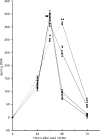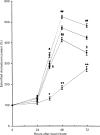Cell cholesterol esters and high-density lipoprotein plasma levels during liver hyperplasia in choline-fed male and female rats
- PMID: 10971745
- PMCID: PMC2517733
- DOI: 10.1046/j.1365-2613.2000.00159.x
Cell cholesterol esters and high-density lipoprotein plasma levels during liver hyperplasia in choline-fed male and female rats
Abstract
Sexual dimorphism exists in the response of rats to lead nitrate, liver hyperplasia occuring earlier and being more pronounced in males. Excess dietary choline in females shifted the growth pattern towards that of males. To determine whether phosphatidylcholine-induced growth modulations could be related to a derangement of cholesterol metabolism, liver accumulation of cholesterol esters and plasma lipoprotein patterns were investigated. In males, lead-induced liver hyperplasia was associated with increased total cholesterol hepatic content, accumulated cholesterol esters and reduced concentration of plasma High Density Lipoprotein (HDL) cholesterol. Females were less responsive to the liver mitogenic signal of lead nitrate; there was no elevation of cholesterol content nor any marked accumulation of cholesterol esters. This is consistent with the lack of change in the plasma levels of HDL cholesterol. Continuous choline feeding displaced the liver cholesterol ester pattern and plasma HDL cholesterol levels in females, and in parallel that of DNA synthesis, towards those of males. Choline was not observed to have any effect in males. These results suggest that the derangement of phosphatidylcholine metabolism induces growth-related changes in cholesterol turnover; they are consistent with the proposal that the intracellular content of cholesterol esters may have a role in regulating liver growth rates.
Figures



Similar articles
-
Hepatic cholesterol in lead nitrate induced liver hyperplasia.Chem Biol Interact. 1984 Mar;48(3):271-9. doi: 10.1016/0009-2797(84)90140-6. Chem Biol Interact. 1984. PMID: 6713595
-
In vivo evaluation of lipoprotein cholesterol ester metabolism in patients with liver disease.Gastroenterology. 1983 Oct;85(4):820-9. Gastroenterology. 1983. PMID: 6884708
-
Cholesterol esters selectively delivered in vivo by high-density-lipoprotein subclass LpA-I to rat liver are processed faster into bile acids than are LpA-I/A-II-derived cholesterol esters.Biochem J. 1993 Jun 15;292 ( Pt 3)(Pt 3):819-23. doi: 10.1042/bj2920819. Biochem J. 1993. PMID: 8318010 Free PMC article.
-
Sexual dimorphism in the regulation of cell turnover during liver hyperplasia.Chem Biol Interact. 1995 Jun 30;97(1):1-10. doi: 10.1016/0009-2797(94)03602-1. Chem Biol Interact. 1995. PMID: 7767937
-
Lipoprotein metabolism in liver disease.Adv Intern Med. 1980;25:117-46. Adv Intern Med. 1980. PMID: 6987838 Review.
References
-
- Brown MS, Goldstein JL. A receptor-mediated pathway for cholesterol homeostasis. Science. 1986;232:34–47. - PubMed
-
- Cui Z, Houweling M, Vance DE. Suppression of rat hepatoma cell growth by expression of phosphatidylethanolamine N methyltransferase 2. J. Biol. Chem. 1994;269:24531–24533. - PubMed
-
- Cui Z, Houweling M, Vance DE. Expression of phosphatidyl–ethanolamine N methyltransferase 2 in Mc Ardle RH7777 hepatoma cells inhibits the CDP-choline pathway for phosphatidylcholine biosynthesis via decreased gene expression of CTP: phosphocholinecytidylyltransferase. Biochem. J. 1995;312:939–945. - PMC - PubMed
-
- Dessi S, Batetta B, Laconi E, Ennas C, Pani P. Hepatic cholesterol in lead nitrate induced liver hyperplasia. Chem. Biol. Interact. 1984;48:271–279. - PubMed
-
- Dessi S, Batetta B, Carrucciu A, Pulisci D, Laconi S, Fadda AM, Anchisi C, Pani P. Variations of serum lipoproteins during cell proliferation induced by lead nitrate. Exp. Mol. Pathol. 1989;51:97–102. - PubMed
Publication types
MeSH terms
Substances
LinkOut - more resources
Full Text Sources

